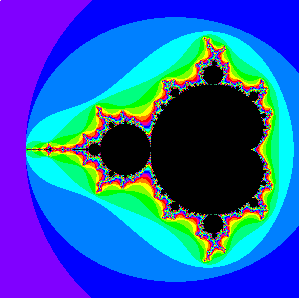Shodor takes a moment to remember Benoit B. Mandelbrot (November 20, 1924 - October 14, 2010), a man often considered the father of fractal geometry. Mandelbrot, who was known for his many contributions to the science and mathematics communities, recently died of pancreatic cancer at the age of 85. Born in Warsaw, Poland, he and his family fled to France to evade the Nazis in 1936. After the war, Mandelbrot studied under Gaston Julia, whose namesake is the Julia Set, at L'École Polytechnique in Paris. Later, he earned a master's degree in aeronautics at the California Institute of Technology. In 1952, Mandelbrot returned to Paris to earn his doctoral degree in mathematics and later studied under mathematician John von Neumann at the Institute for Advanced Study in Princeton, NJ. During a long and distinguished career, Mandelbrot worked at IBM, served as a visiting professor at MIT and Harvard, and in 1987 began teaching at Yale.
Mandelbrot's contributions to math and science are broad and far-reaching, as recognized by his numerous awards and honors, including the Wolf Prize for Physics in 1993 and the Japan Prize for Science and Technology in 2003. Mandelbrot was among the first to study "fractals", a term he coined to describe the self-similar properties of such objects (e.g., ferns, coastlines, and snowflakes). To quote Mandelbrot, "Clouds are not spheres, mountains are not cones, coastlines are not circles, and bark is not smooth, nor does lightning travel in a straight line." Mandelbrot's ability to notice patterns that many others missed eventually led to the discovery of the Mandelbrot Set, named in his honor. The set itself, when displayed graphically, contains beautiful patterns in number, symmetry, and design.

|

|
Mandelbrot's use of computers to find new patterns in the Julia Set is echoed in Shodor's message: through computation, students are able to notice patterns and attach meaning to otherwise abstract concepts. At its foundation in the early 1990's, Shodor was already working with fractals, using the power of supercomputing to make math more accessible to students. The MASTER (Modeling And Simulation Tools for Education Reform) tools are a collection of resources that do just that. In fact, Shodor's fractal microscope, one of the MASTER tools, allows anyone to explore the very same patterns Mandelbrot noticed, while Shodor's many other tools apply the principle of pattern recognition to other fields. Likewise, Shodor's workshops offer guided instruction in computational science and mathematics. On November 11, the fractal workshop will explore patterns in mathematics and nature that were discovered and more fully explained by Mandelbrot and others throughout the mathematics community.